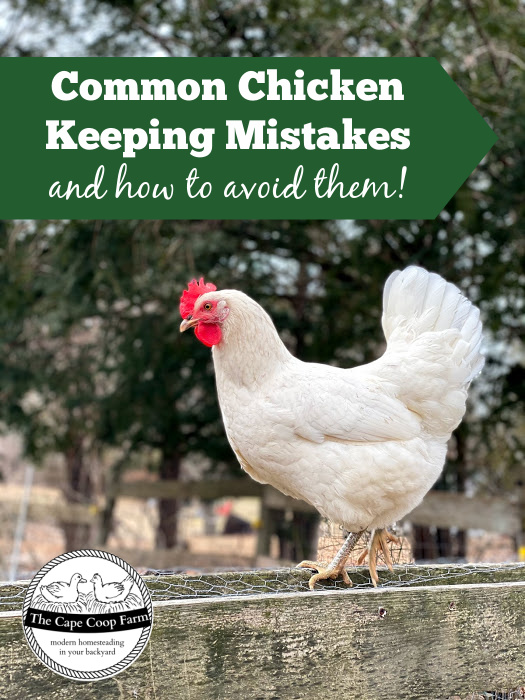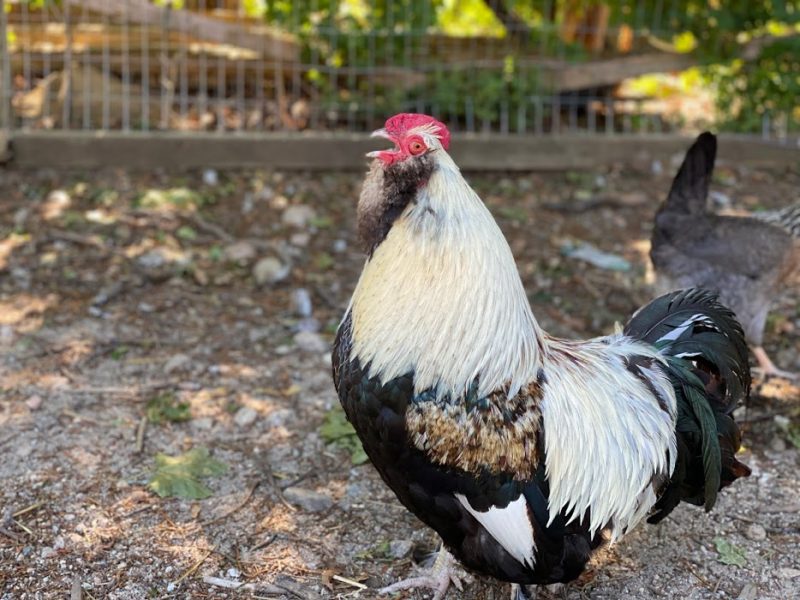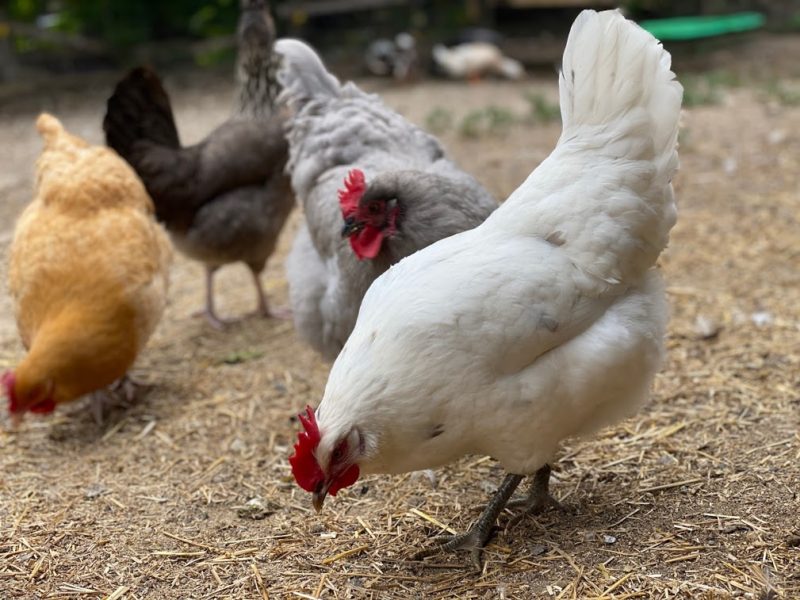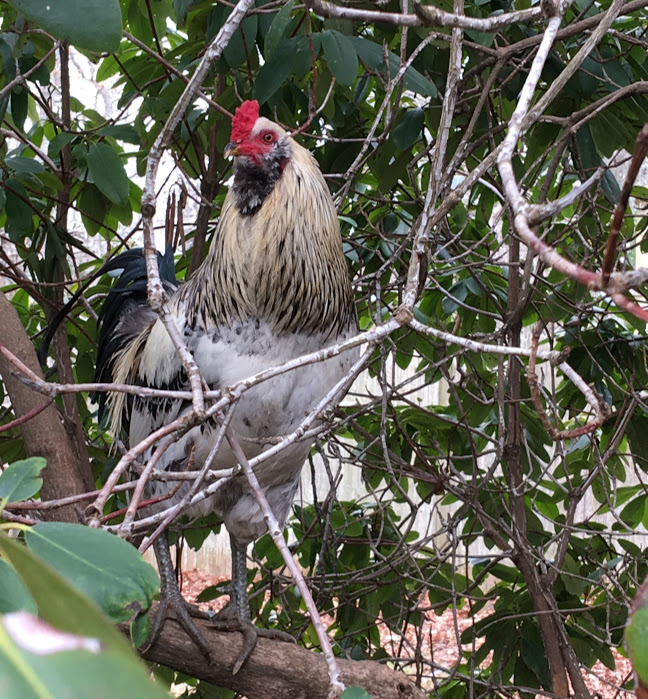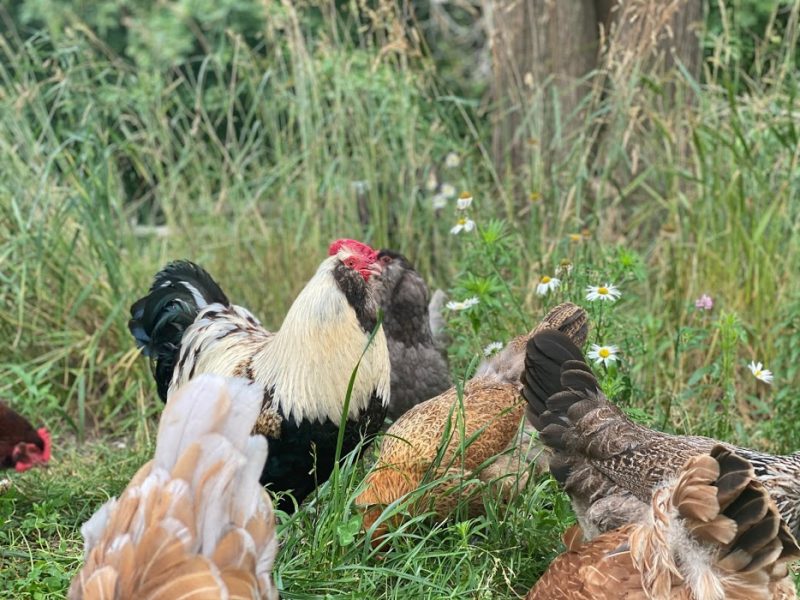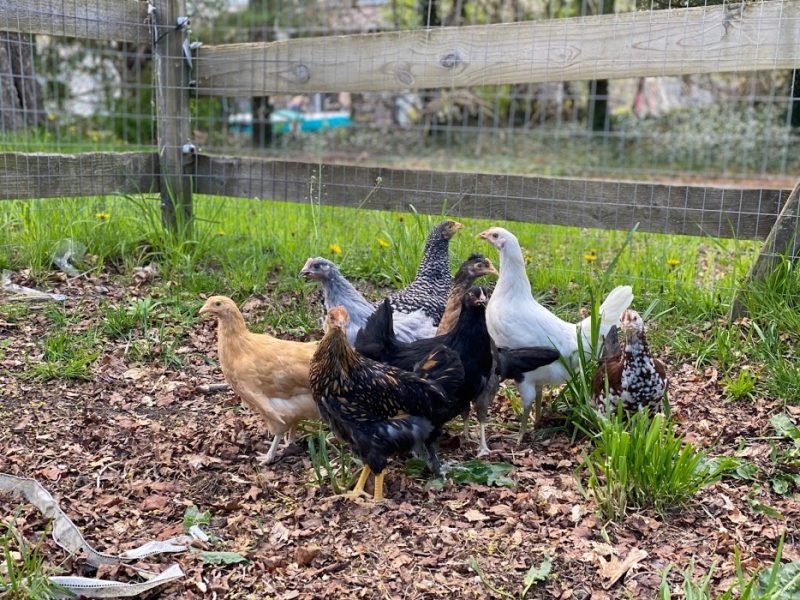---------------------------------------------------------
Anytime you add new livestock to your farm there is a learning curve. All the ins and outs of keeping them happy & healthy can seem overwhelming. Chickens are often the first livestock that people get when dipping their toes into the homesteading waters. Chickens are awesome and are fairly easy to care for, so they make the perfect first farm animal!
But just because they are easy to care for doesn’t mean there isn’t a lot to learn about them. Every day I get messages from fellow chicken keepers who are in over their head or whose mistakes had deadly consequences. Following are the most common chicken keeping mistakes made by new (and sometimes even by experienced chicken keepers).
Buying Straight Run Chicks/Hatching Your Own Eggs
This is one of the most common mistakes that I hear about from inexperienced or first time chicken keepers. You see that full bin of chicks at the feed store and bring home your first flock without asking any questions. Or perhaps you buy some chicks from a backyard breeder. Maybe you have decided that it would be a fun project to hatch some eggs out in an incubator. All of these are fun & valid ways to grow your flock – but only if you are prepared for the consequences. click here to read more about hatching eggs with a broody hen
In the natural order of things, about half of those new babies are going to end up being males. You could get really unlucky and have even more than half of them be roosters. When most people think of keeping a backyard flock, it is to reap the benefits of fresh eggs. If you incubate a dozen eggs and end up with 7 roosters and only 5 hens you are going to end up with several problems. Not only will you not have nearly as many eggs as you hoped, you will have 7 roosters crowing, and possibly fighting over mating rights. If your town doesn’t allow you to keep roosters you are in even more trouble.
Roosters can be hard to rehome because not every chicken keeper wants one. Those that do want a rooster only need one or possibly two. It’s inhumane (and often illegal) to just dump them in the woods. I’ve gotten many a frantic email from a new chicken keeper in this position. Your options are to decide to keep them all if you can, give them to a farmer who is likely to use them as meat, or humanly process them yourself. None of these are particularly pleasant options for a new hobby chicken keeper who just wanted to have a few fresh eggs every day. Roosters aren’t all that bad if you have the space & ability to keep them! Click here to read more about keeping roosters
How to avoid this mistake – unless you are in the market for a rooster always ask if the chicks you are buying are pre-sexed and avoid buying straight run (unsexed) or hatching your own chicks. Buying pre-sexed chicks is usually a bit more expensive but it’s worth the peace of mind. Keep in mind most hatcheries will only offer a 90-95% guarantee for the sex of your pre-sexed chick, so the chance is always there you could end up with an accidental rooster.
Not researching zoning laws
This leads me to the next common mistake which is not researching zoning laws. Before you add any type of animal to your property, you need to make sure you are allowed to keep them. Even if you live in a rural setting with several acres, your town could still have limits on things like how big your flock can be, how close to the property line the coop can be located, if you can free range, or if you can keep a rooster. You might need a permit or have inspections by the board of health. The town could require that you get written permission from abutting neighbors.
I certainly believe that everyone should be allowed to have at least a small flock if they want them, but many towns do not agree with me. You don’t want to invest hundreds of dollars in a coop and get attached to your new little flock only to have the town hit you with fines and make you get rid of the whole set up!
How to avoid this mistake – Do your research BEFORE ordering any chicks or equipment. Start at town hall, they should be able to direct you to the proper department. Sometimes animal regulations are handled by the board of health, or the animal warden, sometimes it’s just the town clerk. Don’t forget to check with your home owner’s association if you have one. Click here for ways to research local bylaws
Not Being Prepared for Predators
If chickens are your first farm animal, it is likely that you have never kept an animal entirely outdoors. Many people new to outdoor animals have never considered the predators lurking in their backyard. Nearly every carnivore on the planet would love a chicken dinner. Even something as small as a few rats could kill a chicken. Talk with other local chicken keepers to see what type of predators might be a danger for birds in your area.
If you live in an area with lots of predators you might not be able to allow your flock to free range. They might only be able to free range under your supervision for a few hours a day. Some of the most common predators for backyard chicken keepers in the US include domestic dogs & cats, hawks, owls, & eagles, skunks, raccoons, foxes, coyotes, snakes, and weasels. Depending on your region you might have to contend with bears, bobcats, mountain lions, alligators, and more.
Many flock owners allow their birds to free range and accept the risk inherit with doing so. Your flock will be happier & healthier but you will eventually lose some birds. Planting bushes or providing other hiding spots throughout the free range area will help them take cover. Keeping a rooster can also be helpful for free range flocks. Even free range flocks should still be locked in a secure coop during the night when predator risk is highest. click here to read more about making the free range decision
How to avoid this mistake – The only way to completely eliminate predator issues is to keep your flock in a predator proof enclosure at all times. This would include a secure coop that the birds are locked into every night. The windows & ventilation openings should be covered by hardware cloth. Attached to the coop should be a secure run. All the sides should be covered with hardware cloth (NOT chicken wire which can bend too easily). The hardware cloth should be buried at least two feet down around the entire perimeter to discourage digging predators. The run roof should either be hardware cloth or a solid surface.
Building or Buying a Too Small Coop/Run
The chicken coop & run are certainly the largest expense in starting up a chicken flock. Unfortunately many commercial coops for sale will WAY overestimate the amount of birds you can fit in the coop. They often use the space requirements set forth by the government for large scale egg factories. Chickens in those factories are miserably kept in tiny cages with only about the size of a piece of standard printer paper to call their own. That is not what you want for your girls! Being kept in cramped conditions is a sure way to spread diseases. The hens will also be aggravated and there will be lots of fighting. Chickens dislike walking in snow and rain, if you live in an area with cold winters or excessive rain, your birds definitely need a decent sized indoor area to retreat to.
To complicate the space matters more, chickens are addictive! Often referred to as “chicken math” people will set out with the intention of keeping a small flock, but then they get those birds and they just want more! There are soooo many interesting breeds of chicken and different colored eggs. Once you are already caring for the flock, adding a few more doesn’t really add to your chores too much so it’s tempting to expand.
Before you know it, the 12 square foot chicken coop that you spent $400 on and was advertised to hold 6 chickens (but really should only hold 3) is busting at the seams and you are already in the market for a new coop!
How to avoid this mistake – Always do your own calculations and NEVER trust the “recommended” amount of birds. You should plan on at least 4 square feet per bird of indoor space and at least 10 square feet per bird of outdoor space. This means to keep a flock of 12 chickens you need at least 48 square feet inside (a 6×8 foot garden shed) PLUS 120 square foot run (the size of an average 10×12 bedroom). Chickens like to roam, the more space you can give them outdoors, the happier they will be! click here to read more about space planning
I always recommend planning for 50% more birds than you think you’ll start out with, unless you know you have a hard flock size limit set by the town. If you don’t expand your flock, great, your small flock will love the extra space. But you will be prepared if the spring chicken catalogs get the best of you! The coop & run are a big investment. Make sure it is one that will last you a long time by being properly sized. I started out with the intention of having just four chickens. Here I am nearly a decade later and I have almost two dozen chickens – plus 12 ducks – in a 300 square foot barn.
Not fencing your free range chickens
So you decided to let your chickens free range – that’s great! Unfortunately you will soon discover that in addition to the predator danger, there are other downsides.
First – chickens do not respect property lines. They will cross the road (hint – it’s usually to get to the other side in search of bugs). They will go in your neighbor’s garden, they will go in your neighbor’s neighbor’s garden. Chickens LOVE to roam and if they are in a group they feel safe with they could wind up very far from home & unsure how to get back. Even worse if your neighbors treat their lawn with pesticides or chemical fertilizer it could kill your flock.
Second – they will destroy your garden. When you first get chickens you might be excited to have birds constantly patrolling the garden eating harmful insects. They will do that, which is great, but on their quest for bugs they will dig up your daffodils, eat your lettuce and strawberries, and just generally scratch dirt & leaves on every pathway and surface.
Third – they poop everywhere. Birds don’t have the ability to control when they poop. They can’t hold it. They can’t be taught to use a litter box or area. Everywhere they walk, they will poop. This will include your lawn furniture, your picnic table, grill, car, porch & patio, your kid’s playset & toys, and all over the lawn. And without fences it will also be all over your neighbor’s belongings too.
How to avoid this mistake – Put up fencing. It doesn’t have to be elaborate, but when free ranging it’s mandatory. The majority of chickens will be stopped by a four foot high fence. It could be wooden pickets, pallets, electrified netting, or just chicken wire. There will be a few motivated birds that can get over a four foot fence. You can clip one of their wings a couple times per year. It doesn’t hurt them, it’s just like a haircut, but it will prevent them from flying. A 6 foot privacy fence will stop pretty much every chicken. Definitely put up fencing along your property line to keep your flock on your own property. But it’s also a good idea to fence off a “human” yard. Give yourself & your family a “poop free” zone to enjoy!
Rushing into introducing new chicks
You just added to your flock, it’s so exciting! You’ve had the chicks inside for over a month and you are ready for them to go outside. When you put your darling little month old babies in the chicken run, your formally sweet and docile adult hens turn into monsters, relentlessly chasing and beating up the babies. If left to their devices, they might even kill them!
Chickens are very territorial, they don’t like newcomers and need time to adjust to the idea of new birds in their space. Its best to do introductions over a few weeks once the chicks are older. You should never just buy day old chicks and assume your adult hens will mother them. Unless you have a properly prepared and broody adult hen, this will almost always end in all the chicks either being pecked to death or ignored and they die from being chilled.
How to avoid this mistake – Once the chicks are over a month old and the nighttime temperatures are at least in the mid 50s you can move them outside. BUT you will need to keep them separated from your big girls. You can section off part of your run & coop with chicken wire. If you don’t have space for that, you can put the babies in a dog crate (be sure they can’t get through the grates) and put the dog crate in the chicken run. If you use a dog crate, you will need to still take the chicks inside or to a secure coop from dusk to dawn to keep them safe. The idea is to let everyone see & smell each other but not get to each other. Let the adults adjust to seeing the younger chicks in their space.
Once the chicks are over 10 weeks old they are big enough to be mixed in with the big girls. They should have been living side by side but separate for several weeks at this point. Start by letting them out to free range together. If that goes well you can try letting the chicks sleep in the coop as well. Just be sure to check on them frequently to ensure no one is getting injured. Click here to read more about introducing new chicks to your flock
